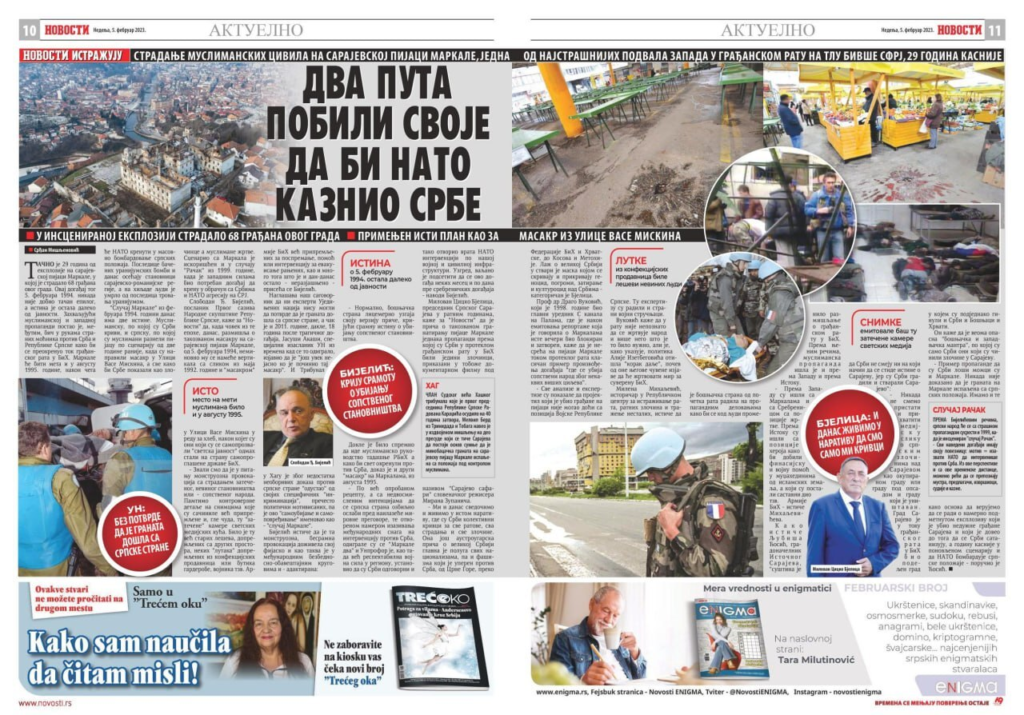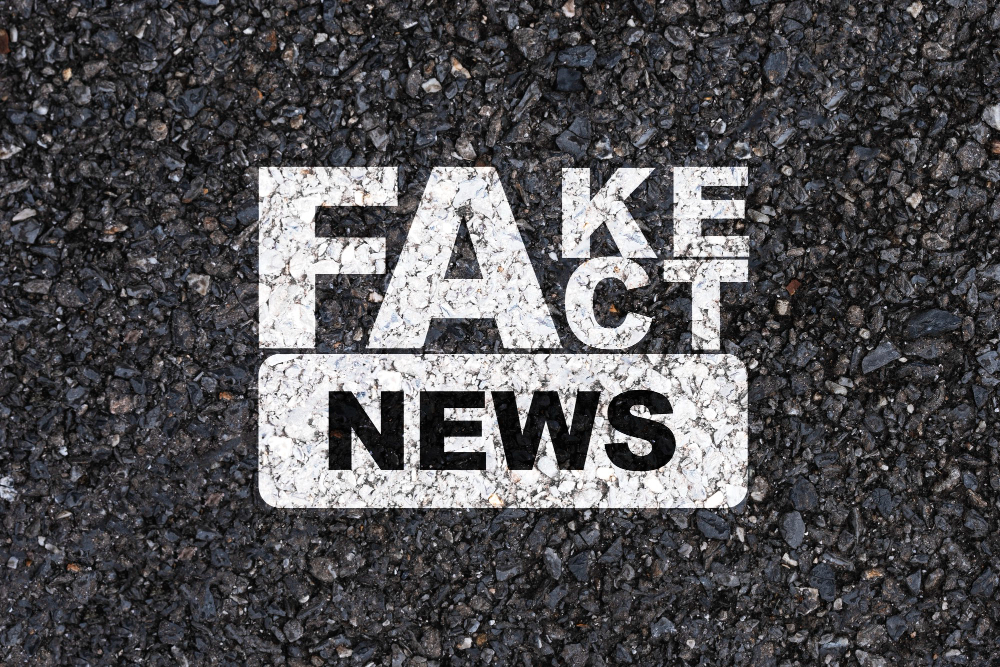Original article (in Bosnian) was published on 07/03/2023
Almost 30 years after the first Markale massacre, the media continue to publish articles denying the facts related to two crimes that happened in this market in which Sarajevo citizens were killed.
After the wars in which Yugoslavia fell apart, the media was one of the levers thanks to which the denial of the facts established by the courts about the committed crimes reached a wider audience. In addition to their earlier role as messengers of political and war propaganda, the actions of certain media even today, three decades after the beginning of the conflict, influence the formation of a distorted public opinion about the events of the war.
Raskrinkavanje recently dealt with this very topic, in an analysis of this year’s examples of media claims that Markale is “a crime attributed to Serbs without evidence”. At that time, we found out that such claims have been reported by the media for years, mostly around the time of the anniversary of the first Markale massacre.
In addition to media articles, these kinds of narratives are spread in the media space to a much greater extent through the statements of officials and other interlocutors. In one part of the media, such statements are shared without additional media articles and claims, while in another part of the media, articles with statements are enriched with the conclusions and claims of the authors themselves. In the latest example of media denial of the facts, the flywheel was Milorad Dodik’s statement, which the media used to place their claims.
The most recent example of such “complicity” of the media, officials and other actors in spreading narratives denying established facts about crimes, is an article published in the printed edition of Vecernje novosti regarding the anniversary of the massacre this year. On February 5, 2023, the 10th and 11th pages of this paper featured an article whose title contains a claim that illustrates one of the most widespread inaccurate narratives about the two massacres on the Sarajevo market – that the citizens died in staged crimes.
THEY KILLED THEIR OWN PEOPLE TWICE SO THAT NATO WOULD PUNISH THE SERBS

On February 4, 2023, the article was announced on the web portal Novosti with the following claims:
HOW MUSLIMS KILLED THEIR OWN PEOPLE TWICE SO THAT NATO WOULD PUNISH THE SERBS: The “Markale” case, tomorrow, in the weekly “Novosti”.
The staged explosion in which, 29 years ago, 68 Sarajevo citizens died, when the terrible scenario of the Vaso Miskin Street massacre was applied, remains to this day one of the most terrible hoaxes of the West in the civil war in the former SFRY.
Intermagazin, Opstina Sokolac, Sedma Sila, RT Balkan, IN4S and others shared the article from the press.
Relativizing facts and “two truths”
In addition to the title, the text also contains other theses that deny responsibility for the crimes in Markale. The shelling of Markale is called “Muslim and Western propaganda”, and for the crimes themselves, it is stated that there are “two truths” – one according to which “Serbs are guilty” and the other according to which “Muslims” caused fatal explosions in the market in order to provoke an international intervention in the war. The “scenario of the other truth”, as it is stated, was repeated in the case of the massacre in the Kosovo village of Racak (which happened on January 15, 1999), for which NATO intervened in the then FR Yugoslavia.
The article by Vecernje novosti contains the statements of Slobodan Bijelic, deputy of the first convocation of the National Assembly of the RS, mayor of the municipality of Sokolac Milovan Bjelica, Milena Mihaljevic, a historian at the Republic Center for Research on War, War Crimes and the Search for the Missing, Prof. Dr. Drago Vukovic, who in 1998 was the main editor of the S channel in Pale, and Ljubisa Cosic, mayor of East Sarajevo.
Bijelic compared the “staged” crime in Markale to the earlier massacre in the bread line in the then Vaso Miskin Street, after which “the self-proclaimed world public immediately sided with the self-proclaimed state of Bosnia and Herzegovina”. In his statement, he mentioned “controversial details” of the Markale massacre, such as “already set cameras of world media companies”, old corpses and dolls from boutique windows, soldiers of the “so-called Army of Bosnia and Herzegovina” prepared for evacuating the wounded – which, according to him, remains unexplained to this day.
The article summarizes Bijelic’s claims regarding the statement of UN special envoy Yasushi Akashi from 2011 that “it is unclear who started the massacre”.
Our interlocutor emphasizes that even the experts of the United Nations could not confirm that the grenade came from the Serbian side, and even in 2011, that is, 18 years after the tragic event, Yasushi Akashi, the UN special envoy from the time when it took place, stated that “it is still unclear who committed the massacre”. Due to the lack of irrefutable evidence against the Serbian side, the Tribunal in The Hague also “gave up” its specific “incriminations”, which were too often politically motivated, and named this “suicide and self-harm” as the “Markale case”.
Negative statements of Slobodan D. Bijelic, who relativizes the massacre at the Tuzla Gate in addition to the crime in Markale, were published on February 5 in another article by Novosti.
Vukovic described the Markale massacre as an “accident” and an example of the production of events in which “one’s people are killed for the sake of higher goals”. He also said that the projectile that killed the citizens in the market could not have been fired from the positions of the VRS, which was allegedly confirmed by analyzes and expertise of foreign military experts.
In the end, Ljubisa Cosic said that “it has never been proven that a grenade was fired at Markale from Serbian positions” and that there is a basis for believing that it was a deliberately planted explosive that killed innocent citizens of Sarajevo.
The author of the text only looks at the Hague court at the end, in the context of the separate opinion of the member of the judicial council from Trinidad and Tobago, Melville Baird, on the part of the verdict against Karadzic that related to the crimes in Sarajevo. The judge then said that there is a reasonable doubt that the mortar shell was fired at Markale from a position under the control of “Bosnian Muslims”, that is, the authorities in Sarajevo.
At the end of the article, there is a review of the “Racak case”, which Bijelic claimed was also staged. He concluded that the common link in all these cases is the same motive: “to provoke NATO to intervene against the Serbs”.
What are the facts?
The judicial panel of the Hague Tribunal established the facts about the Markale massacres in the cases against Stanislav Galic in 2003 (shelling in 1994) and Dragomir Milosevic in 2007 (for shelling in 1995), which were later cited in other judgments, including Radovan Karadzic.
https://raskrinkavanje.ba/analiza/odgovornost-za-masakr-na-markalama-nije-pripisana-vrs-u-bez-dokaza
In addition to the fact that it was confirmed that the grenade was fired from the position of the SRK, in the verdict against Stanislav Galic, the Court stated that the claim of intentional targeting of civilians by the ABiH is unreasonable and contradicts the facts.
The majority believes that the claim that ABiH forces would target their civilians, as was the case here, is not only unreasonable but also contrary to proven legally relevant facts.
Claims that Markale was shelled by “Muslims”, that is, forces under the control of the government in Sarajevo, are therefore incorrect.
The denial of the facts is also argued by the statement of the then UN envoy in which he expressed doubts about the direction from which the fired grenade came, as well as separate opinions of the judges of the Hague Tribunal, which are taken as confirmation of the theses about staged massacres.
Yasushi Akashi, who was the special envoy of the UN Secretary-General for the Balkans in 1994 and 1995, did state that the crime at Sarajevo’s Markale market was still an “unclear case” and that the grenade that killed the citizens could have come from both warring parties. Detektor reports that Akashi later told the Belgrade media that his statement cannot change the facts established in the Hague Tribunal and will not affect the ongoing processes.
Judge Melville Baird did separate his opinion in the judgment against Karadzic, in the part that refers to Sarajevo (pages 2557-2565 of the Verdict). The effect of the “separated opinion” on revisionism was explained for the web portal Detektor by the former Hague Tribunal investigator Nevenka Tromp, speaking in the context of the separated opinions in the verdict against VRS General Ratko Mladic:
Verdicts should reflect the balance of the narrative and declare whether the defendant is guilty beyond all doubt of the charges in the indictment, explains former Hague Tribunal investigator Nevenka Tromp.
“Separate opinions often replicate the dominant narrative of the Defense – ‘not guilty’, or the Prosecution – ‘guilty’. And so regardless of the verdict – these separate opinions leave a lot of room for revisionism”, she says.
Finally, Istinomer from Serbia wrote about the “Racak case”. This is an operation by the MUP and the Yugoslav Army in retaliation for the shooting of members of a police patrol by the Kosovo Liberation Army (KLA):
The Hague Tribunal found that on January 15, 1999, at least 45 Kosovo Albanians were killed in a joint operation by the MUP and the Yugoslav Army, which was carried out in Racak in response to the killing of members of a police patrol by the KLA a few days earlier.
The Hague Tribunal confirmed these facts in the verdict against Vlastimir Djordjevic.
Our partner web portal Istinomjer rated Ljubisa Cosic’s statements from articles by Vecernje novosti as untrue in an analysis published on February 20, 2023.
Therefore, we evaluate the latest examples of claims that the Markale massacres and the one that happened in Vaso Miskin Street (today Ferhadija) were staged, that is, that they were organized and committed by the then BiH Army, as the distribution of fake news. According to Raskrinkavanje’s methodology, the earliest media report (or publication) of some factually unfounded claim is classified as fake news, but in this case, it is not possible to determine with certainty who published such claims first, given that they have been repeated in the public space since the 1990s.
These claims are also evaluated as a conspiracy theory because of the allegations that the crimes were organized so they can be attributed to the Army of the Republic of Srpska and thereby encourage foreign military intervention.
Allegations about the massacre in Racak receive the same rating.



